Case Study: Pharma 1000 - Medication Analysis and Patient Education
VerifiedAdded on 2022/08/10
|8
|1284
|23
Case Study
AI Summary
This case study analyzes the medication administration for a patient, Mrs. Kim, who is prescribed Amitriptyline hydrochloride (Elavil) for depression and Metformin hydrochloride (Glycon) for Type 2 Diabetes. The analysis includes the assessment of the 'rights' of medication administration, such as the right medication, dose, time, route, patient, documentation, assessment, and patient education. It also addresses potential patient noncompliance and suggests interventions. The study further discusses the importance of patient teaching regarding herbal medicines, emphasizing the need for informed decisions due to the lack of rigorous testing compared to traditional medicines. The assignment provides detailed calculations for dosages, considerations for patient-specific factors like diabetes, and references relevant sources to support the analysis.
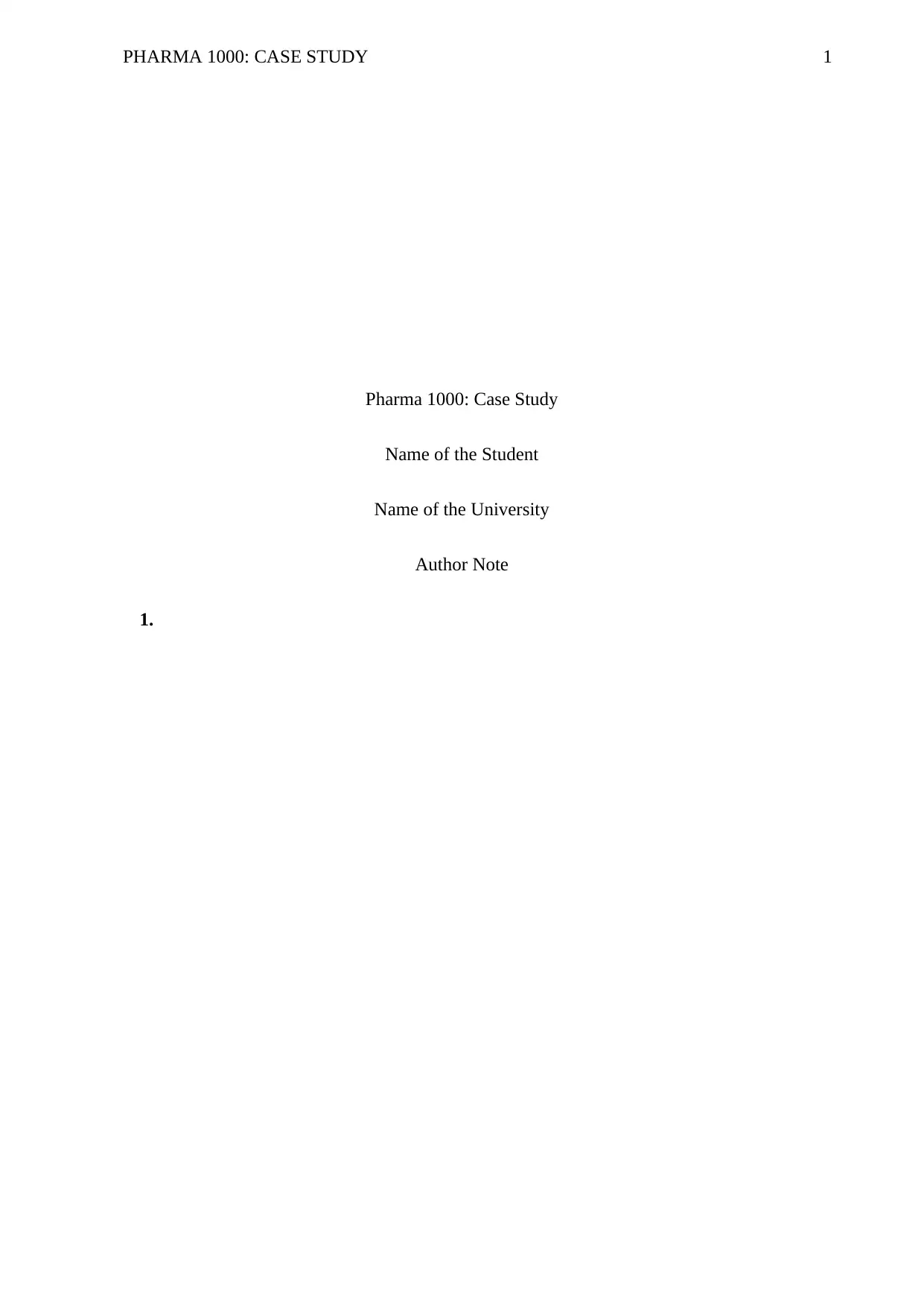
1PHARMA 1000: CASE STUDY
Pharma 1000: Case Study
Name of the Student
Name of the University
Author Note
1.
Pharma 1000: Case Study
Name of the Student
Name of the University
Author Note
1.
Paraphrase This Document
Need a fresh take? Get an instant paraphrase of this document with our AI Paraphraser
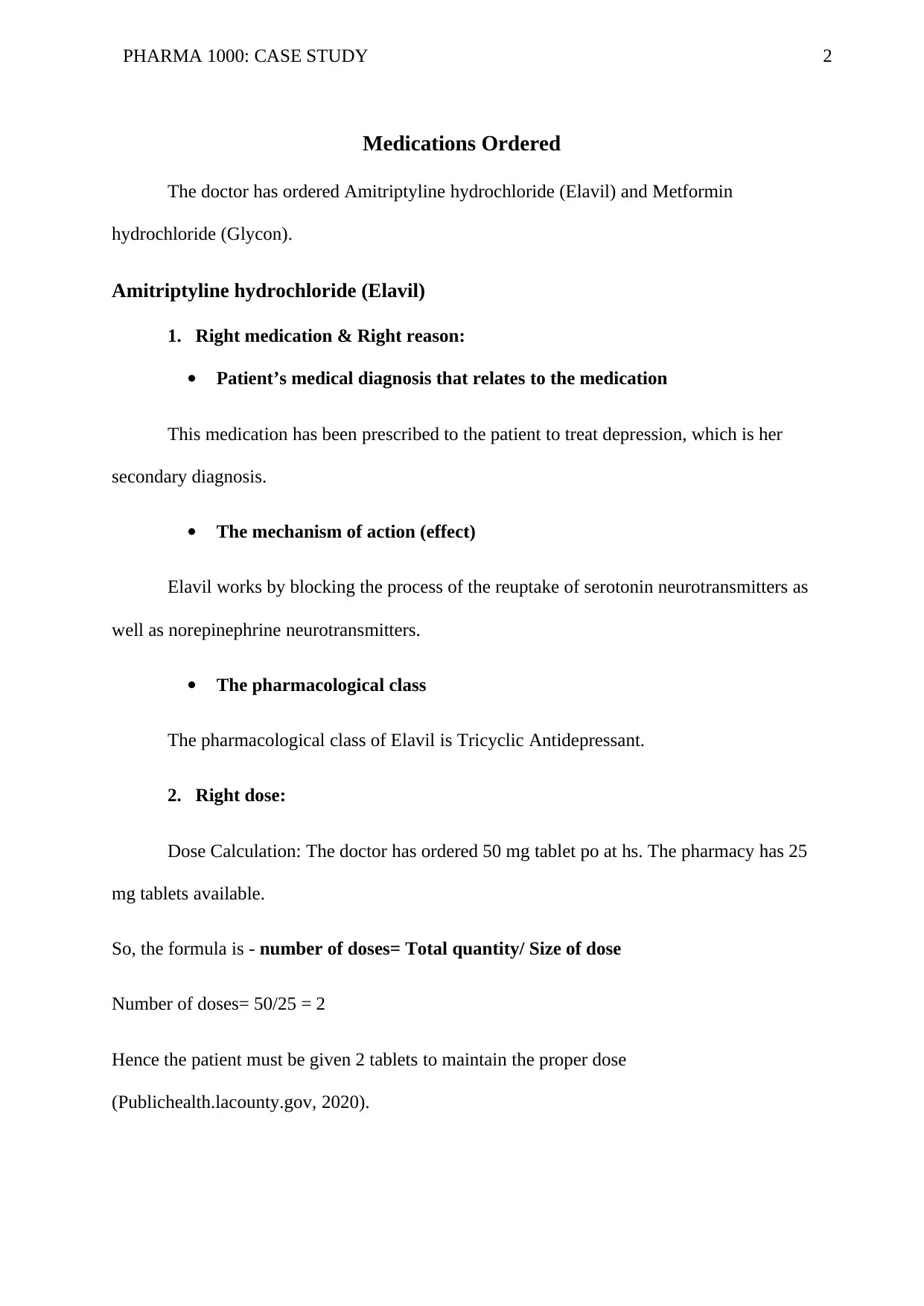
2PHARMA 1000: CASE STUDY
Medications Ordered
The doctor has ordered Amitriptyline hydrochloride (Elavil) and Metformin
hydrochloride (Glycon).
Amitriptyline hydrochloride (Elavil)
1. Right medication & Right reason:
Patient’s medical diagnosis that relates to the medication
This medication has been prescribed to the patient to treat depression, which is her
secondary diagnosis.
The mechanism of action (effect)
Elavil works by blocking the process of the reuptake of serotonin neurotransmitters as
well as norepinephrine neurotransmitters.
The pharmacological class
The pharmacological class of Elavil is Tricyclic Antidepressant.
2. Right dose:
Dose Calculation: The doctor has ordered 50 mg tablet po at hs. The pharmacy has 25
mg tablets available.
So, the formula is - number of doses= Total quantity/ Size of dose
Number of doses= 50/25 = 2
Hence the patient must be given 2 tablets to maintain the proper dose
(Publichealth.lacounty.gov, 2020).
Medications Ordered
The doctor has ordered Amitriptyline hydrochloride (Elavil) and Metformin
hydrochloride (Glycon).
Amitriptyline hydrochloride (Elavil)
1. Right medication & Right reason:
Patient’s medical diagnosis that relates to the medication
This medication has been prescribed to the patient to treat depression, which is her
secondary diagnosis.
The mechanism of action (effect)
Elavil works by blocking the process of the reuptake of serotonin neurotransmitters as
well as norepinephrine neurotransmitters.
The pharmacological class
The pharmacological class of Elavil is Tricyclic Antidepressant.
2. Right dose:
Dose Calculation: The doctor has ordered 50 mg tablet po at hs. The pharmacy has 25
mg tablets available.
So, the formula is - number of doses= Total quantity/ Size of dose
Number of doses= 50/25 = 2
Hence the patient must be given 2 tablets to maintain the proper dose
(Publichealth.lacounty.gov, 2020).
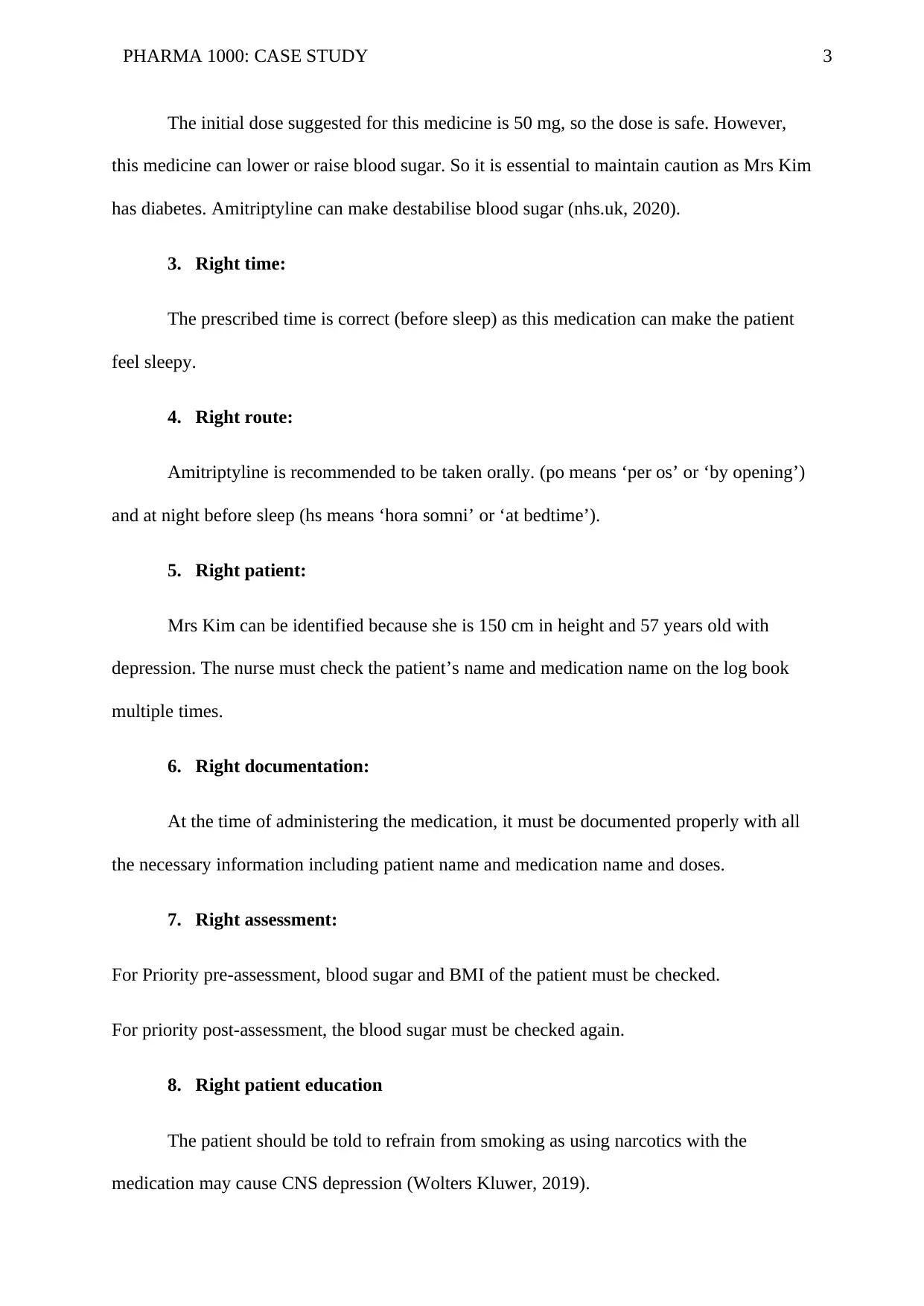
3PHARMA 1000: CASE STUDY
The initial dose suggested for this medicine is 50 mg, so the dose is safe. However,
this medicine can lower or raise blood sugar. So it is essential to maintain caution as Mrs Kim
has diabetes. Amitriptyline can make destabilise blood sugar (nhs.uk, 2020).
3. Right time:
The prescribed time is correct (before sleep) as this medication can make the patient
feel sleepy.
4. Right route:
Amitriptyline is recommended to be taken orally. (po means ‘per os’ or ‘by opening’)
and at night before sleep (hs means ‘hora somni’ or ‘at bedtime’).
5. Right patient:
Mrs Kim can be identified because she is 150 cm in height and 57 years old with
depression. The nurse must check the patient’s name and medication name on the log book
multiple times.
6. Right documentation:
At the time of administering the medication, it must be documented properly with all
the necessary information including patient name and medication name and doses.
7. Right assessment:
For Priority pre-assessment, blood sugar and BMI of the patient must be checked.
For priority post-assessment, the blood sugar must be checked again.
8. Right patient education
The patient should be told to refrain from smoking as using narcotics with the
medication may cause CNS depression (Wolters Kluwer, 2019).
The initial dose suggested for this medicine is 50 mg, so the dose is safe. However,
this medicine can lower or raise blood sugar. So it is essential to maintain caution as Mrs Kim
has diabetes. Amitriptyline can make destabilise blood sugar (nhs.uk, 2020).
3. Right time:
The prescribed time is correct (before sleep) as this medication can make the patient
feel sleepy.
4. Right route:
Amitriptyline is recommended to be taken orally. (po means ‘per os’ or ‘by opening’)
and at night before sleep (hs means ‘hora somni’ or ‘at bedtime’).
5. Right patient:
Mrs Kim can be identified because she is 150 cm in height and 57 years old with
depression. The nurse must check the patient’s name and medication name on the log book
multiple times.
6. Right documentation:
At the time of administering the medication, it must be documented properly with all
the necessary information including patient name and medication name and doses.
7. Right assessment:
For Priority pre-assessment, blood sugar and BMI of the patient must be checked.
For priority post-assessment, the blood sugar must be checked again.
8. Right patient education
The patient should be told to refrain from smoking as using narcotics with the
medication may cause CNS depression (Wolters Kluwer, 2019).
⊘ This is a preview!⊘
Do you want full access?
Subscribe today to unlock all pages.

Trusted by 1+ million students worldwide
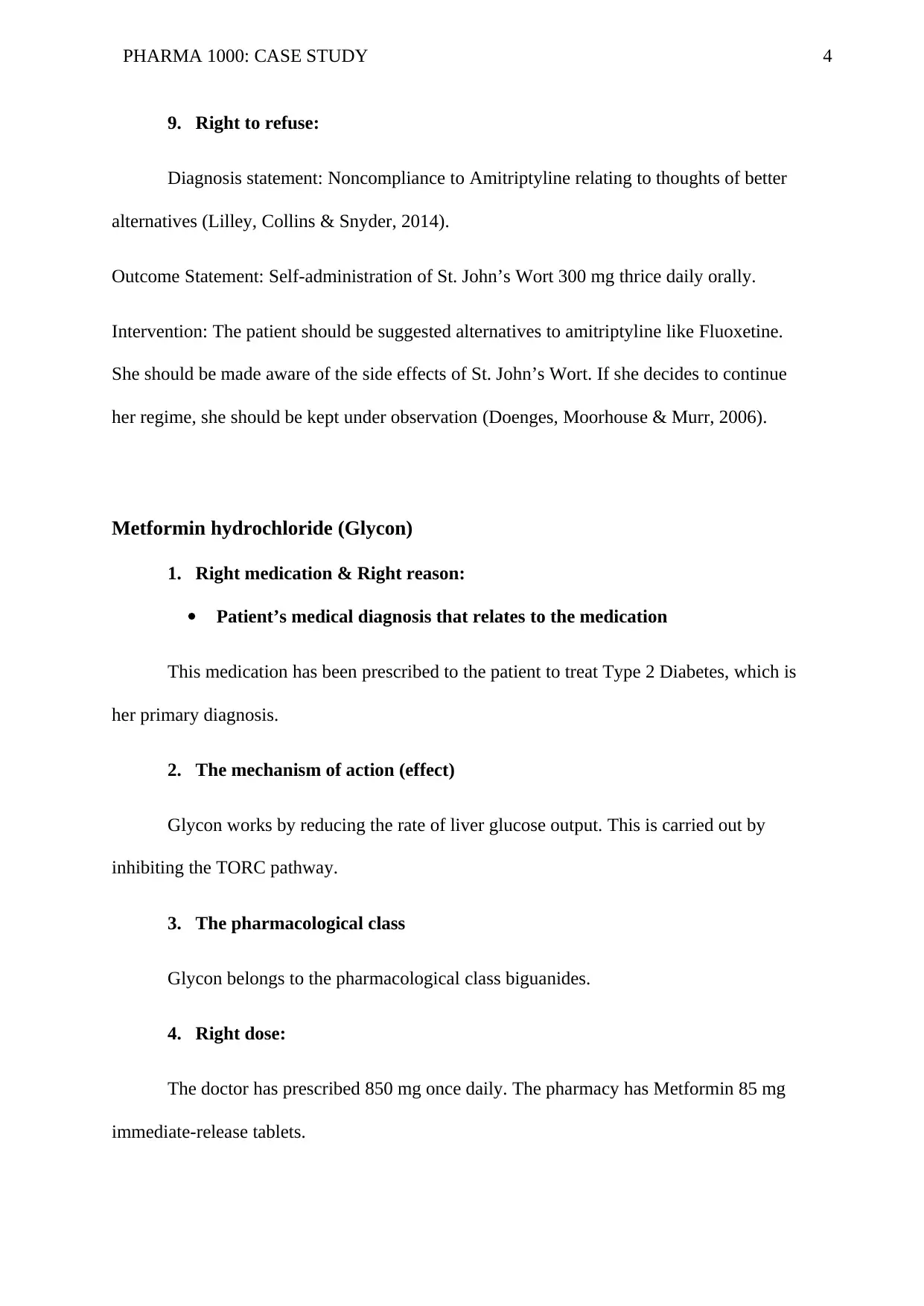
4PHARMA 1000: CASE STUDY
9. Right to refuse:
Diagnosis statement: Noncompliance to Amitriptyline relating to thoughts of better
alternatives (Lilley, Collins & Snyder, 2014).
Outcome Statement: Self-administration of St. John’s Wort 300 mg thrice daily orally.
Intervention: The patient should be suggested alternatives to amitriptyline like Fluoxetine.
She should be made aware of the side effects of St. John’s Wort. If she decides to continue
her regime, she should be kept under observation (Doenges, Moorhouse & Murr, 2006).
Metformin hydrochloride (Glycon)
1. Right medication & Right reason:
Patient’s medical diagnosis that relates to the medication
This medication has been prescribed to the patient to treat Type 2 Diabetes, which is
her primary diagnosis.
2. The mechanism of action (effect)
Glycon works by reducing the rate of liver glucose output. This is carried out by
inhibiting the TORC pathway.
3. The pharmacological class
Glycon belongs to the pharmacological class biguanides.
4. Right dose:
The doctor has prescribed 850 mg once daily. The pharmacy has Metformin 85 mg
immediate-release tablets.
9. Right to refuse:
Diagnosis statement: Noncompliance to Amitriptyline relating to thoughts of better
alternatives (Lilley, Collins & Snyder, 2014).
Outcome Statement: Self-administration of St. John’s Wort 300 mg thrice daily orally.
Intervention: The patient should be suggested alternatives to amitriptyline like Fluoxetine.
She should be made aware of the side effects of St. John’s Wort. If she decides to continue
her regime, she should be kept under observation (Doenges, Moorhouse & Murr, 2006).
Metformin hydrochloride (Glycon)
1. Right medication & Right reason:
Patient’s medical diagnosis that relates to the medication
This medication has been prescribed to the patient to treat Type 2 Diabetes, which is
her primary diagnosis.
2. The mechanism of action (effect)
Glycon works by reducing the rate of liver glucose output. This is carried out by
inhibiting the TORC pathway.
3. The pharmacological class
Glycon belongs to the pharmacological class biguanides.
4. Right dose:
The doctor has prescribed 850 mg once daily. The pharmacy has Metformin 85 mg
immediate-release tablets.
Paraphrase This Document
Need a fresh take? Get an instant paraphrase of this document with our AI Paraphraser
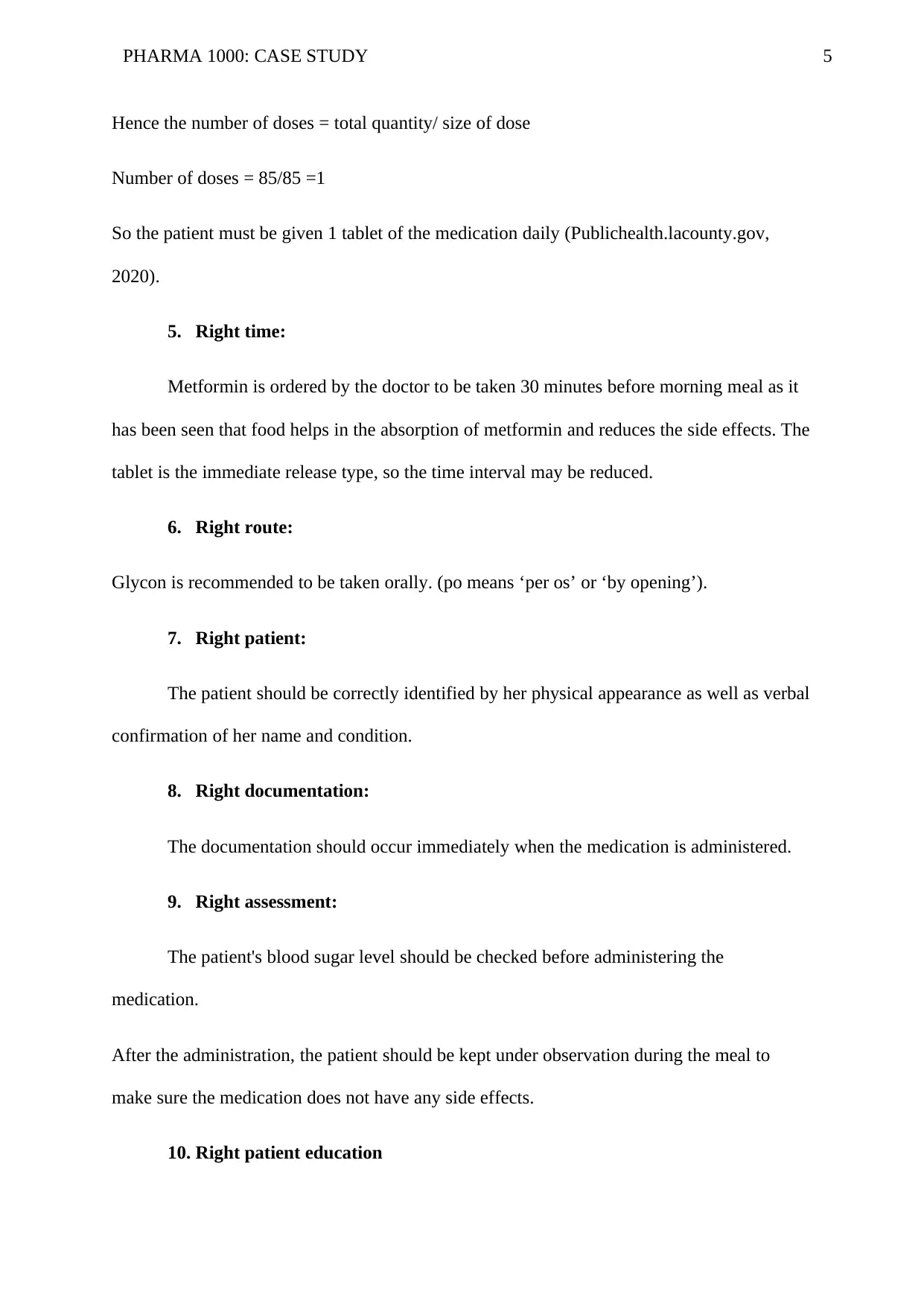
5PHARMA 1000: CASE STUDY
Hence the number of doses = total quantity/ size of dose
Number of doses = 85/85 =1
So the patient must be given 1 tablet of the medication daily (Publichealth.lacounty.gov,
2020).
5. Right time:
Metformin is ordered by the doctor to be taken 30 minutes before morning meal as it
has been seen that food helps in the absorption of metformin and reduces the side effects. The
tablet is the immediate release type, so the time interval may be reduced.
6. Right route:
Glycon is recommended to be taken orally. (po means ‘per os’ or ‘by opening’).
7. Right patient:
The patient should be correctly identified by her physical appearance as well as verbal
confirmation of her name and condition.
8. Right documentation:
The documentation should occur immediately when the medication is administered.
9. Right assessment:
The patient's blood sugar level should be checked before administering the
medication.
After the administration, the patient should be kept under observation during the meal to
make sure the medication does not have any side effects.
10. Right patient education
Hence the number of doses = total quantity/ size of dose
Number of doses = 85/85 =1
So the patient must be given 1 tablet of the medication daily (Publichealth.lacounty.gov,
2020).
5. Right time:
Metformin is ordered by the doctor to be taken 30 minutes before morning meal as it
has been seen that food helps in the absorption of metformin and reduces the side effects. The
tablet is the immediate release type, so the time interval may be reduced.
6. Right route:
Glycon is recommended to be taken orally. (po means ‘per os’ or ‘by opening’).
7. Right patient:
The patient should be correctly identified by her physical appearance as well as verbal
confirmation of her name and condition.
8. Right documentation:
The documentation should occur immediately when the medication is administered.
9. Right assessment:
The patient's blood sugar level should be checked before administering the
medication.
After the administration, the patient should be kept under observation during the meal to
make sure the medication does not have any side effects.
10. Right patient education
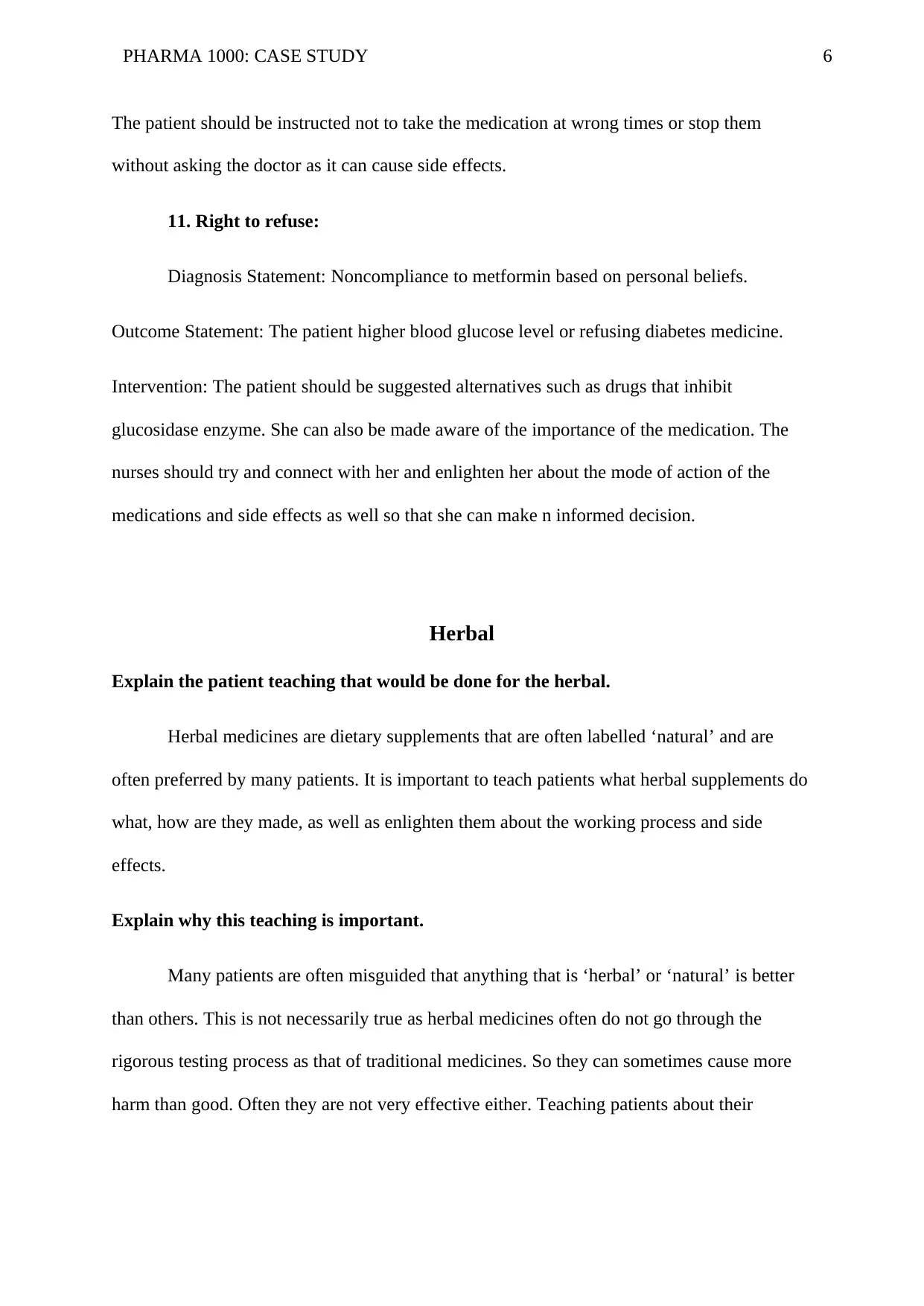
6PHARMA 1000: CASE STUDY
The patient should be instructed not to take the medication at wrong times or stop them
without asking the doctor as it can cause side effects.
11. Right to refuse:
Diagnosis Statement: Noncompliance to metformin based on personal beliefs.
Outcome Statement: The patient higher blood glucose level or refusing diabetes medicine.
Intervention: The patient should be suggested alternatives such as drugs that inhibit
glucosidase enzyme. She can also be made aware of the importance of the medication. The
nurses should try and connect with her and enlighten her about the mode of action of the
medications and side effects as well so that she can make n informed decision.
Herbal
Explain the patient teaching that would be done for the herbal.
Herbal medicines are dietary supplements that are often labelled ‘natural’ and are
often preferred by many patients. It is important to teach patients what herbal supplements do
what, how are they made, as well as enlighten them about the working process and side
effects.
Explain why this teaching is important.
Many patients are often misguided that anything that is ‘herbal’ or ‘natural’ is better
than others. This is not necessarily true as herbal medicines often do not go through the
rigorous testing process as that of traditional medicines. So they can sometimes cause more
harm than good. Often they are not very effective either. Teaching patients about their
The patient should be instructed not to take the medication at wrong times or stop them
without asking the doctor as it can cause side effects.
11. Right to refuse:
Diagnosis Statement: Noncompliance to metformin based on personal beliefs.
Outcome Statement: The patient higher blood glucose level or refusing diabetes medicine.
Intervention: The patient should be suggested alternatives such as drugs that inhibit
glucosidase enzyme. She can also be made aware of the importance of the medication. The
nurses should try and connect with her and enlighten her about the mode of action of the
medications and side effects as well so that she can make n informed decision.
Herbal
Explain the patient teaching that would be done for the herbal.
Herbal medicines are dietary supplements that are often labelled ‘natural’ and are
often preferred by many patients. It is important to teach patients what herbal supplements do
what, how are they made, as well as enlighten them about the working process and side
effects.
Explain why this teaching is important.
Many patients are often misguided that anything that is ‘herbal’ or ‘natural’ is better
than others. This is not necessarily true as herbal medicines often do not go through the
rigorous testing process as that of traditional medicines. So they can sometimes cause more
harm than good. Often they are not very effective either. Teaching patients about their
⊘ This is a preview!⊘
Do you want full access?
Subscribe today to unlock all pages.

Trusted by 1+ million students worldwide
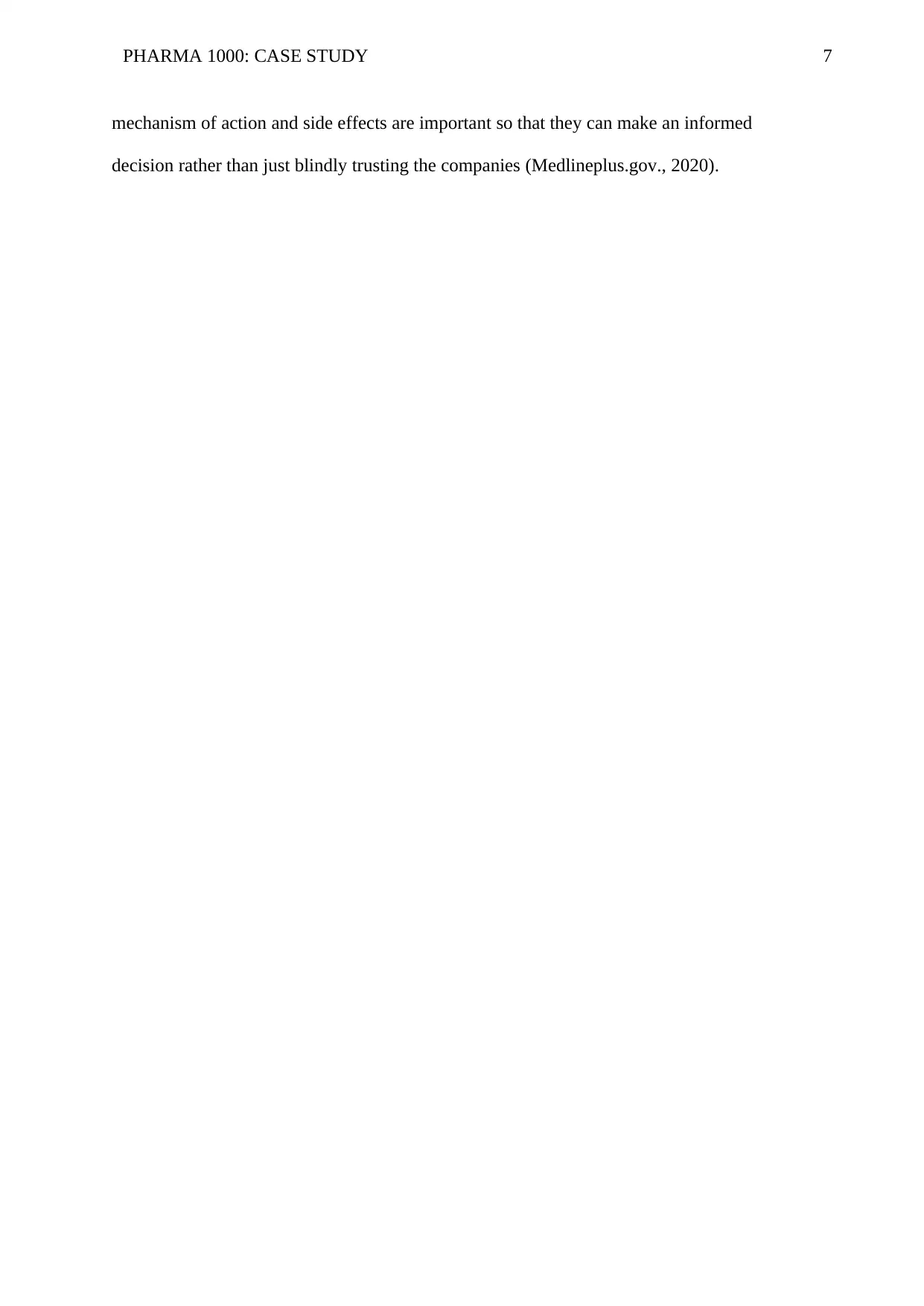
7PHARMA 1000: CASE STUDY
mechanism of action and side effects are important so that they can make an informed
decision rather than just blindly trusting the companies (Medlineplus.gov., 2020).
mechanism of action and side effects are important so that they can make an informed
decision rather than just blindly trusting the companies (Medlineplus.gov., 2020).
Paraphrase This Document
Need a fresh take? Get an instant paraphrase of this document with our AI Paraphraser
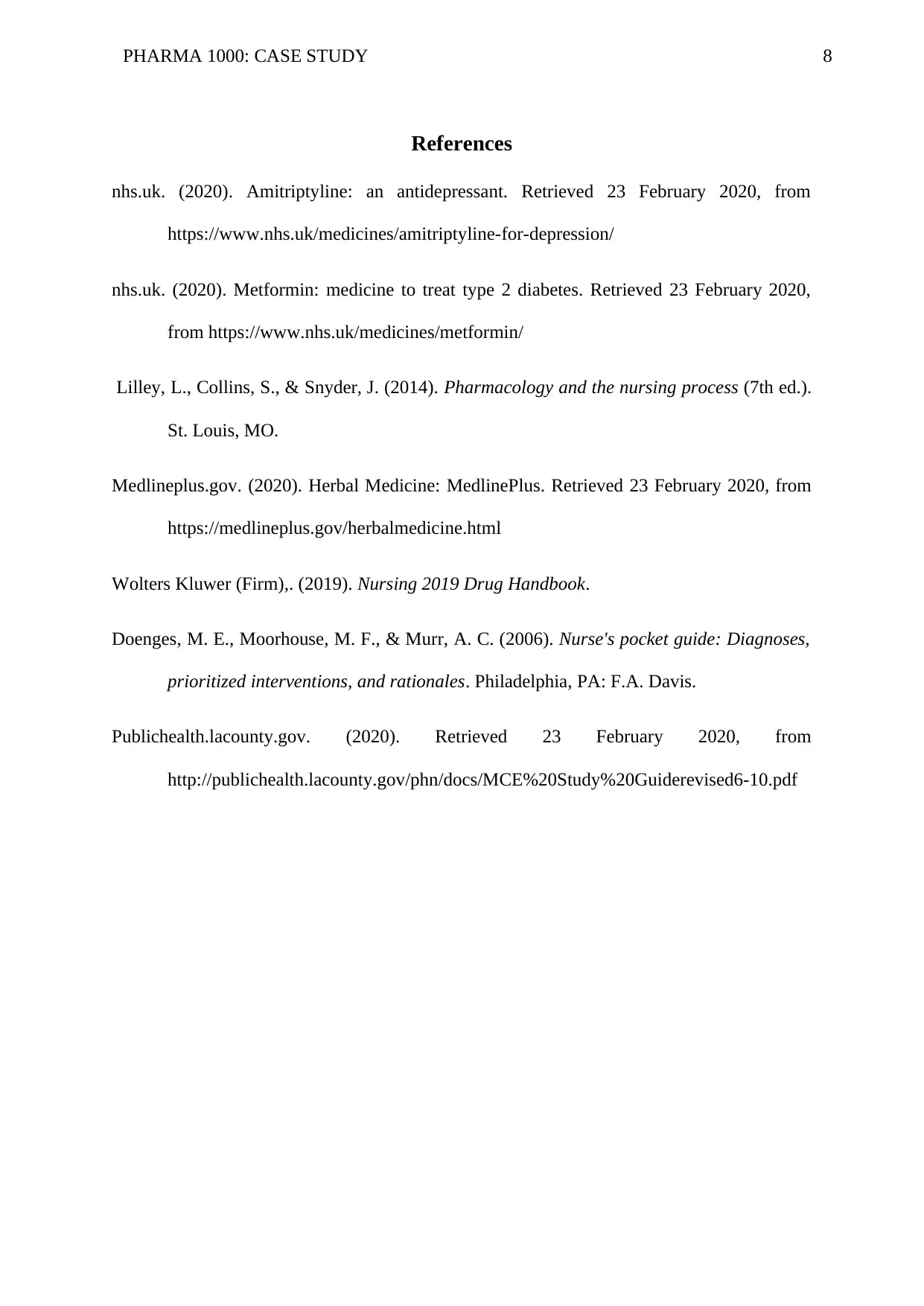
8PHARMA 1000: CASE STUDY
References
nhs.uk. (2020). Amitriptyline: an antidepressant. Retrieved 23 February 2020, from
https://www.nhs.uk/medicines/amitriptyline-for-depression/
nhs.uk. (2020). Metformin: medicine to treat type 2 diabetes. Retrieved 23 February 2020,
from https://www.nhs.uk/medicines/metformin/
Lilley, L., Collins, S., & Snyder, J. (2014). Pharmacology and the nursing process (7th ed.).
St. Louis, MO.
Medlineplus.gov. (2020). Herbal Medicine: MedlinePlus. Retrieved 23 February 2020, from
https://medlineplus.gov/herbalmedicine.html
Wolters Kluwer (Firm),. (2019). Nursing 2019 Drug Handbook.
Doenges, M. E., Moorhouse, M. F., & Murr, A. C. (2006). Nurse's pocket guide: Diagnoses,
prioritized interventions, and rationales. Philadelphia, PA: F.A. Davis.
Publichealth.lacounty.gov. (2020). Retrieved 23 February 2020, from
http://publichealth.lacounty.gov/phn/docs/MCE%20Study%20Guiderevised6-10.pdf
References
nhs.uk. (2020). Amitriptyline: an antidepressant. Retrieved 23 February 2020, from
https://www.nhs.uk/medicines/amitriptyline-for-depression/
nhs.uk. (2020). Metformin: medicine to treat type 2 diabetes. Retrieved 23 February 2020,
from https://www.nhs.uk/medicines/metformin/
Lilley, L., Collins, S., & Snyder, J. (2014). Pharmacology and the nursing process (7th ed.).
St. Louis, MO.
Medlineplus.gov. (2020). Herbal Medicine: MedlinePlus. Retrieved 23 February 2020, from
https://medlineplus.gov/herbalmedicine.html
Wolters Kluwer (Firm),. (2019). Nursing 2019 Drug Handbook.
Doenges, M. E., Moorhouse, M. F., & Murr, A. C. (2006). Nurse's pocket guide: Diagnoses,
prioritized interventions, and rationales. Philadelphia, PA: F.A. Davis.
Publichealth.lacounty.gov. (2020). Retrieved 23 February 2020, from
http://publichealth.lacounty.gov/phn/docs/MCE%20Study%20Guiderevised6-10.pdf
1 out of 8
Your All-in-One AI-Powered Toolkit for Academic Success.
+13062052269
info@desklib.com
Available 24*7 on WhatsApp / Email
![[object Object]](/_next/static/media/star-bottom.7253800d.svg)
Unlock your academic potential
Copyright © 2020–2025 A2Z Services. All Rights Reserved. Developed and managed by ZUCOL.